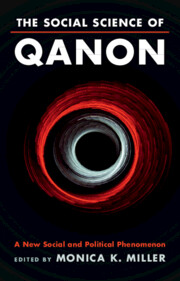Book contents
- The Social Science of QAnon
- The Social Science of QAnon
- Copyright page
- Dedication
- Contents
- Contributors
- Preface
- Part I Introduction to QAnon
- Part II Recruiting and Maintaining Followers
- Part III QAnon and Society
- Part IV The Role of Communication in Promoting and Limiting QAnon Support
- Chapter 12 QAnon and Social Media
- Chapter 13 Social Network Analysis Techniques Using NodeXL for Analyzing Disinformation Related to QAnon
- Chapter 14 QAnon, Folklore, and Conspiratorial Consensus
- Chapter 15 Debunking and Preventing Conspiracies
- Part V The Future of QAnon
- Index
- References
Chapter 12 - QAnon and Social Media
from Part IV - The Role of Communication in Promoting and Limiting QAnon Support
Published online by Cambridge University Press: 14 September 2023
- The Social Science of QAnon
- The Social Science of QAnon
- Copyright page
- Dedication
- Contents
- Contributors
- Preface
- Part I Introduction to QAnon
- Part II Recruiting and Maintaining Followers
- Part III QAnon and Society
- Part IV The Role of Communication in Promoting and Limiting QAnon Support
- Chapter 12 QAnon and Social Media
- Chapter 13 Social Network Analysis Techniques Using NodeXL for Analyzing Disinformation Related to QAnon
- Chapter 14 QAnon, Folklore, and Conspiratorial Consensus
- Chapter 15 Debunking and Preventing Conspiracies
- Part V The Future of QAnon
- Index
- References
Summary
This chapter discusses the interaction between QAnon and the media. As the group turned from fringe to mainstream, it swamped social media. Eventually, social media companies had to take measures to stop the spread of disinformation associated with QAnon. Groups such as QAnon might use media to manipulate news frames and set agendas, which propels conspiracy-laden topics to mainstream media sources, and creates a platform for spreading disinformation. This chapter also examines how social media use relates to belief in conspiracy theories, and the potential consequences of exposure to conspiracy theories on social media platforms. This relationship between conspiracies, media, and disinformation is explored and applied to QAnon. A brief discussion of how QAnon is similar or different from other groups in their use of social media is offered, along with some research questions for future study about the QAnon movement.
- Type
- Chapter
- Information
- The Social Science of QAnonA New Social and Political Phenomenon, pp. 195 - 215Publisher: Cambridge University PressPrint publication year: 2023
References
- 1
- Cited by



